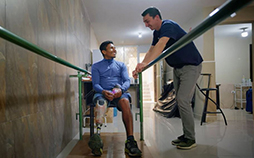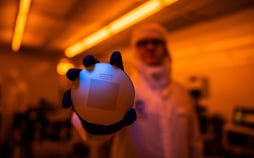Inspiring Learning: Putting Independence Back Within Reach
BYU students and Prótesis Imbabura work to make more affordable prosthetics for people in Ecuador.
February 2025
Robots could be very beneficial to humans, but most present-day robots are not equipped to safely work alongside people. BYU students have been working to change that.
Graduate student Curtis Johnson and other students worked with engineering professor and robotics expert Marc Killpack to build a revolutionary robot. According to Johnson, a doctoral student in mechanical engineering, the team started its work with a question: “What if the robot could push with its shoulder or push things out of the way with its whole body?” And that is exactly the kind of robot the team built.
The robot, named Baloo, has a flexible structure that enables it to safely lift large and unwieldy objects. Inflexible structures or hard components on robots can “either break the robot or break you, whichever one is stronger,” Johnson says. If soft robots like Baloo can be taught to do helpful tasks, they could become safer working companions for humans.
Several graduate students in robotics have completed master’s theses that focus on improving robot–human cooperation on set tasks. For his thesis, Shaden Moss helped program a robot to follow an object that is co-manipulated by a person with a VR headset. Moss analyzed how the stiffness in the arm of the robot affected the way the person with the VR headset completed cooperative tasks, such as moving a table in various directions.
In his thesis, Dallin Cordon developed a control system that mapped the movement of the flexible robotic arm to allow the robot to work more dexterously with humans. “No one has ever really done collaborative manipulation with a soft robot, so this is a novel approach,” Cordon says. “I think the first moment when it worked—even if it didn’t work well—was exciting because it finally did what we wanted it to do. That was electrifying.”
The work is part of a National Robotics Initiative project, funded by the National Science Foundation.

BYU students and Prótesis Imbabura work to make more affordable prosthetics for people in Ecuador.

Innovative BYU engineering students have etched what they believe is the smallest physical copy of the Book of Mormon on a thin silicon microchip.

A team of BYU design and nursing students decided to see what they could do to help women in Haridwar, India. While on campus, the students studied the situation, presented their findings, and secured funding to travel to India.